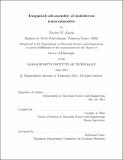| dc.contributor.advisor | Caroline A. Ross. | en_US |
| dc.contributor.author | Aimon, Nicolas M | en_US |
| dc.contributor.other | Massachusetts Institute of Technology. Department of Materials Science and Engineering. | en_US |
| dc.date.accessioned | 2014-09-19T21:30:27Z | |
| dc.date.available | 2014-09-19T21:30:27Z | |
| dc.date.copyright | 2014 | en_US |
| dc.date.issued | 2014 | en_US |
| dc.identifier.uri | http://hdl.handle.net/1721.1/89948 | |
| dc.description | Thesis: Ph. D., Massachusetts Institute of Technology, Department of Materials Science and Engineering, 2014. | en_US |
| dc.description | Cataloged from PDF version of thesis. | en_US |
| dc.description | Includes bibliographical references (pages 133-150). | en_US |
| dc.description.abstract | To respond to the growing demand for smart and connected devices, such as smartphones, tablet PCs arid other mobile hardware, while meeting the needs for increased power efficiency, miniaturization and reduced manufacturing costs, new material solutions need to be considered. These should address the shortcomings of incumbent semiconductor-based technologies which provide a limited number of functionalities, suffer from high power consumption and heat dissipation, and whose conventional planar processing is increasingly complex and resource-intensive. Potential replacement materials include complex oxides, which exhibit interesting physical phenomena such as superconductivity, colossal magnetoresistance and multiferroicity. New functionalities are especially found at interfaces between two oxides, including emergent electronic states like two-dimensional electron gases, enhanced ionic transport and magnetoelectric coupling, among many other. In this this thesis, we focus on self-assembled oxide nanocomposites, which elegantly organize into vertical nanostructures via spontaneous phase-separation, naturally forming numerous such heterointerfaces. These provide a rich playground for studying interfacial effects, which could be used in future devices, and the self-assembly promises cheap arid high throughput manufacturing providing it can be integrated into useful architectures. BiFeO₃-CoFe₂O₄ self-assembled nanocomposites, in particular, have been studied for the magnetoelectric coupling that takes place between the ferrimagnetic spinel phase, which forms discrete vertical pillars, arid the ferroelectric perovskite phase, which forms a matrix that surrounds the spinel pillars. Here, after an in-depth study of the mechanisms responsible for the formation of this self-assembled nanostructure, we develop a templating method enabling the precise control over the morphology of the film, resulting in useful structures for potential devices like magnetoelectric memories and logic devices. To study the structural, magnetic and electrical properties of our samples, a set of experimental and theoretical methods is developed, adapted to the unique requirements of these thin film nanostructures with iicron-scale ordering. Using finite element analysis and micromagnetic modeling, the effect of the strain-mediated magnetoelectic coupling on the magnetic switching of the CoFe₂O₄ nanopillars is predicted. Scanning Probe Microscopy is also used to characterize the local ferroelectric and magnetic behavior, and observe, for the first time in these templated composites, electrically-induced magnetic switching of the pillar magnetization. The tools and methods developed in this thesis could pave the way towards a wider use of templated self-assembly to leverage the promising properties of oxide heterointerfaces and enable their use in future devices with low manufacturing costs. | en_US |
| dc.description.statementofresponsibility | by Nicolas M. Airmon. | en_US |
| dc.format.extent | 150 pages | en_US |
| dc.language.iso | eng | en_US |
| dc.publisher | Massachusetts Institute of Technology | en_US |
| dc.rights | M.I.T. theses are protected by copyright. They may be viewed from this source for any purpose, but reproduction or distribution in any format is prohibited without written permission. See provided URL for inquiries about permission. | en_US |
| dc.rights.uri | http://dspace.mit.edu/handle/1721.1/7582 | en_US |
| dc.subject | Materials Science and Engineering. | en_US |
| dc.title | Templated self-assembly of multiferroic nanocomposites | en_US |
| dc.type | Thesis | en_US |
| dc.description.degree | Ph. D. | en_US |
| dc.contributor.department | Massachusetts Institute of Technology. Department of Materials Science and Engineering | |
| dc.identifier.oclc | 890127160 | en_US |
